Technology
Ten Years of Digital Progress
Building an Inclusive and Future-Ready India
Posted On:
30 JUN 2025 10:16AM
|
Key Takeaways
- Internet connections increased from 25.15 crore in 2014 to 96.96 crore in 2024.
- 4.74 lakh 5G towers installed, covering 99.6% of districts.
- UPI recorded 1,867.7 crore transactions worth ₹24.77 lakh crore in April 2025.
- DigiLocker has 53.92 crore users; UMANG offers 2,300 services in 23 languages.
- Digital economy contributed 11.74% to GDP in 2022–23; projected to reach 13.42% in 2024–25.
- BharatNet connected 2.18 lakh Gram Panchayats with high-speed internet.
|
Digital India: Power to Empower
 On 1st July 2025, India celebrates 10 years of the Digital India journey. Launched by Prime Minister Narendra Modi in 2015, the aim was simple, to use technology to make life easier for every Indian.
On 1st July 2025, India celebrates 10 years of the Digital India journey. Launched by Prime Minister Narendra Modi in 2015, the aim was simple, to use technology to make life easier for every Indian.
From bringing internet access to remote corners of the country to making government services available online, the initiative has truly bridged the digital divide. Today, people can access healthcare, education, banking, and other services with just a few clicks.
The digital economy is also growing fast, contributing 11.74% to the national income in 2022–23 and expected to reach 13.42% by 2024–25. According to the State of India’s Digital Economy Report 2024, released by ICRIER Prosus Centre for Internet and Digital Economy (IPCIDE), India now ranks third in the world for digitalisation of the economy. By 2030, India’s digital economy is projected to contribute nearly one-fifth of the country’s overall economy, outpacing the growth of traditional sectors.
Powered by innovations in artificial intelligence, cloud computing, and strong digital infrastructure, Digital India has created new opportunities and empowered millions. As we mark this milestone, one thing is clear, Digital India has not just brought technology closer to people, it has brought people closer to opportunity.
Key focus Areas and Services Under Digital India
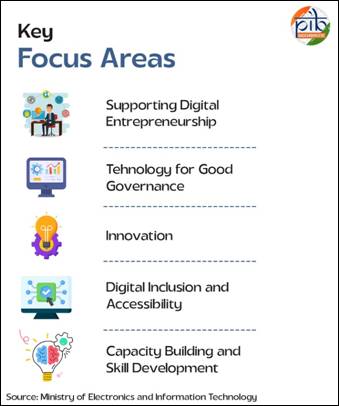
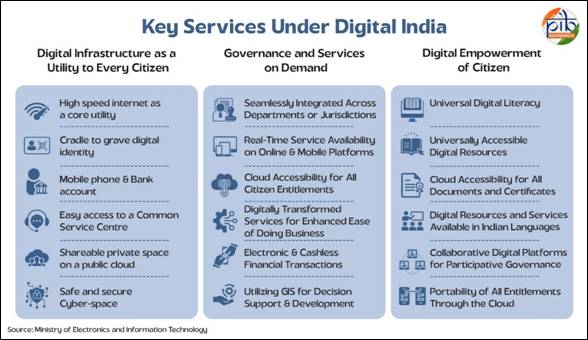
Key Milestones of the Digital India Journey
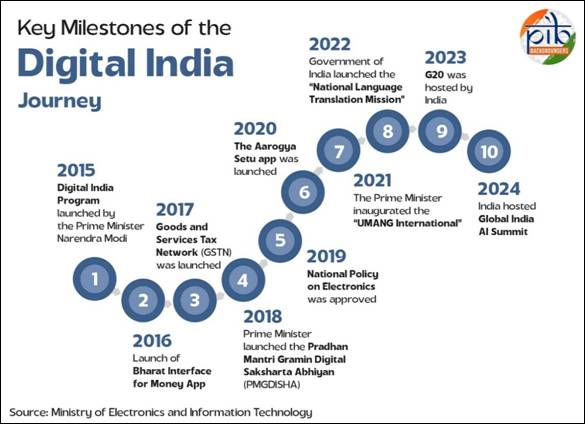
Connectivity and Infrastructure
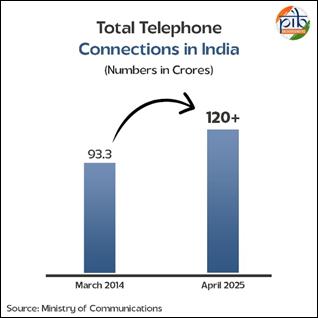 Over the years, Digital India has built strong digital infrastructure across the country. Mobile connectivity has expanded to almost every village. Public internet centres have opened up access for all. Digital services have made governance faster and more transparent. These efforts have laid the foundation for a truly connected India.
Over the years, Digital India has built strong digital infrastructure across the country. Mobile connectivity has expanded to almost every village. Public internet centres have opened up access for all. Digital services have made governance faster and more transparent. These efforts have laid the foundation for a truly connected India.
Telecom and Internet Penetration
Total telephone connections in India rose from 93.3 crore in March 2014 to over 120 crores in April 2025, with tele-density increasing from 75.23% to 84.49% by October 2024. Urban connections grew from 555.23 million to 661.36 million, and rural connections from 377.78 million to 527.34 million, between March 2014 and October 2024.
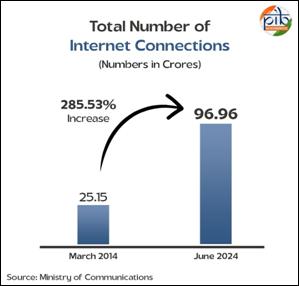 Internet & Broadband Penetration
Internet & Broadband Penetration
Internet connections jumped from 25.15 crore in March 2014 to 96.96 crore in June 2024, registering a growth of 285.53%.
- Broadband connections rose from 6.1 crore in March, 2014 to 94.92 crore in August, 2024 growing by 1452%.
- Out of 6,44,131 villages, 6,15,836 villages have 4G mobile connectivity in the country, as of December 2024.
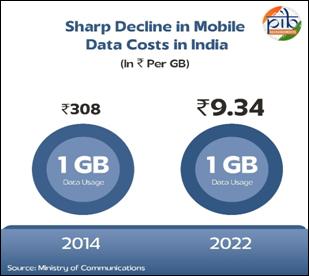 Since 2016, 4G coverage quickly reached every part of India. Then, 5G launched in October 2022, speeding up digital services even more. In 22 months, India set up 4.74 lakh 5G towers, covering 99.6% of districts. In 2023–24 alone, 2.95 lakh towers were added.
Since 2016, 4G coverage quickly reached every part of India. Then, 5G launched in October 2022, speeding up digital services even more. In 22 months, India set up 4.74 lakh 5G towers, covering 99.6% of districts. In 2023–24 alone, 2.95 lakh towers were added.
This strong mobile network supports 116 crore users in 2025. Internet users have grown by 285% in 11 years. At the same time, data costs dropped from ₹308 per GB in 2014 to just ₹9.34 in 2022, making the internet more affordable for everyone.
BharatNet: Linking Villages to the Internet
A major part of this digital push has been about connecting rural India. As of January 2025, BharatNet has connected over 2.18 lakh Gram Panchayats with high-speed internet. Nearly 6.92 lakh km of optical fibre cable has been laid, bringing internet to many villages.
Digital Finance and Inclusion
UPI
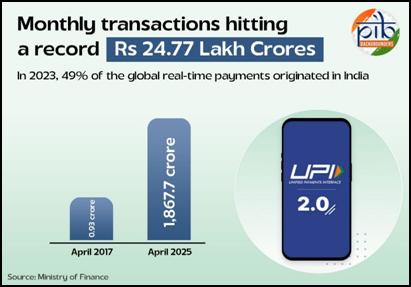
In April 2025, over 1,867.7 crore UPI transactions worth ₹24.77 lakh crore were made in one month. Nearly 460 million people and 65 million merchants use UPI. According to the ACI Worldwide Report 2024, India handled 49% of global real-time transactions in 2023. UPI is now live in over seven countries, boosting global digital payments and financial inclusion.
Aadhaar: Building Trust with Technology
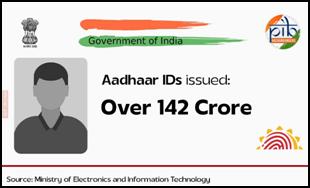 The Aadhaar-based e-KYC system has helped simplify processes in both banking and public services. It made verification faster, reduced paperwork, and brought transparency across sectors. As of April 2025, 142 crore Aadhaar IDs have been generated.
The Aadhaar-based e-KYC system has helped simplify processes in both banking and public services. It made verification faster, reduced paperwork, and brought transparency across sectors. As of April 2025, 142 crore Aadhaar IDs have been generated.
Direct Benefits Transfer (DBT):
DBT uses Aadhaar to deliver welfare payments directly and remove fake beneficiaries. It saved the government over ₹3.48 lakh crore between 2015 and March 2023. By May 2025, ₹44 lakh crore has been transferred through DBT. Over 5.87 crore ineligible ration cards and 4.23 crore duplicate LPG connections were cancelled making the welfare system more targeted and transparent.
Open Network for Digital Commerce (ONDC):
Launched in 2022, ONDC helps small businesses enter digital markets. By January 2025, it covers 616+ cities and has registered more than 7.64 lakh sellers and service providers.
Government e-Marketplace (GeM):
Launched in 2016, Government e-Marketplace (GeM) enables online purchase of goods and services by government departments. As of January 2025, GeM recorded a Gross Merchandise Value (GMV) of ₹4.09 lakh crore in just 10 months of FY 2024–25, showing nearly 50% growth over the same period last year. It has over 1.6 lakh government buyers and 22.5 lakh+ sellers and service providers.
Advancing Strategic Tech Capabilities
India is strengthening its position in advanced technologies like AI and semiconductors to become a global innovation hub.
IndiaAI Mission:
Approved on 7 March 2024, the IndiaAI Mission aims to build a strong and inclusive AI ecosystem with a budget of ₹10,371.92 crore over five years. It focuses on enabling access to computing, supporting innovation, improving datasets, funding startups, and ensuring ethical AI use. By 30 May 2025, India’s national compute power crossed 34,000 GPUs, marking a major milestone in AI infrastructure growth.
Key Pillars of the IndiaAI Mission:
- IndiaAI Innovation Centre – Develops and deploys indigenous Large Multimodal Models and domain-specific foundational models.
- IndiaAI Application Development Initiative – Promotes scalable AI solutions for large-scale social and economic transformation.
- AIKosh Platform – A unified hub for datasets, models, AI sandbox environments, and tools to boost innovation.
- IndiaAI Compute Capacity – Builds a scalable ecosystem with over 10,000 GPUs through public-private partnerships (now crossed 34,000 GPUs).
- IndiaAI Startup Financing – Accelerates deep-tech AI startups by improving access to funding for innovative projects.
- IndiaAI FutureSkills – Expands AI education at all levels and sets up Data & AI Labs in Tier 2 and Tier 3 cities.
- Safe & Trusted AI – Ensures responsible and ethical AI development through tools, checklists, and governance frameworks.
India Semiconductor Mission
 The India Semiconductor Mission (ISM) aims to build a strong semiconductor and display ecosystem, positioning India as a global hub for electronics manufacturing and design, while serving as the nodal agency for the efficient and seamless implementation of semiconductor and display schemes. With a ₹76,000 crore outlay, the mission supports local chip and display manufacturing. It offers up to 50% support for fabs and incentives for chip design and production.
The India Semiconductor Mission (ISM) aims to build a strong semiconductor and display ecosystem, positioning India as a global hub for electronics manufacturing and design, while serving as the nodal agency for the efficient and seamless implementation of semiconductor and display schemes. With a ₹76,000 crore outlay, the mission supports local chip and display manufacturing. It offers up to 50% support for fabs and incentives for chip design and production.
As of 14 May 2025, six semiconductor projects worth ₹1.55 lakh crore have been approved. Five units are under construction. The latest project is a joint venture between HCL and Foxconn to build a display chip unit near Jewar airport, Uttar Pradesh.
SEMICON INDIA 2025
The 'SEMICON INDIA 2025' will be organised by India Semiconductor Mission in partnership with SEMI and industry associations under the leadership of Prime Minister Shri Narendra Modi with the aim to positioning India as a trusted partner in the global Semiconductor Supply Chain to drive forward the vision of the India Semiconductor Mission.
E-Governance: Empowering Citizens, Enabling Change
E-Governance in India has revolutionized the way citizens interact with the government by making services more accessible, transparent, and efficient. Through robust digital platforms, it has empowered both citizens and officials, enhancing ease of governance across the country.
- Karmayogi Bharat + iGOT: Under Mission Karmayogi, the platform trains civil servants with the right Attitude, Skills, and Knowledge. As of May 2025, over 1.21 crore officials are onboarded, with 2,588 courses and 3.24 crore learning certificates issued. It supports online, face-to-face, and blended learning formats.
- DigiLocker: Launched in 2015, DigiLocker offers citizens access to digital documents. By June 2025, users reached 53.92 crore. In 2024, 2031.99 lakh users signed up, compared to just 9.98 lakh in 2015.
- UMANG: Launched in 2017, UMANG is a single mobile platform for citizens to access services from Central to Local Government.As of June 2025, it has 8.34 crore user registrations and 597 crore transactions. The app offers 2,300 services in 23 Indian languages.
Bhashini – Breaking Language Barriers
BHASHINI helps people access digital services in their own language. It uses AI to break language barriers.As of May 2025, BHASHINI supports 35+ languages with over 1,600 AI models and 18 language services. It is integrated into widely used platforms such as IRCTC, NPCI’s IVRS systems, and police documentation, making essential services more inclusive and accessible for all. With over 8.5 lakh mobile app downloads, BHASHINI continues to empower citizens to engage with digital platforms in the language of their choice.
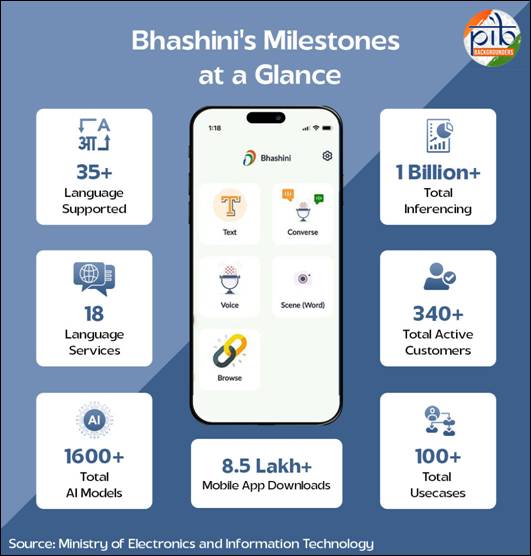
Conclusion
In just a decade, Digital India has reshaped the nation’s digital landscape—connecting villages to the world, making governance more transparent, and opening up new avenues for growth and innovation. With record adoption of digital payments, rapid internet expansion, and pathbreaking initiatives in AI and semiconductors, India has built a digital ecosystem that is inclusive, scalable, and future-ready.
As the country moves forward under the vision of Viksit Bharat, Digital India stands as a powerful catalyst—bridging gaps, empowering citizens, and driving India’s emergence as a global technology leader. The next decade promises not just faster growth, but deeper transformation, where technology becomes the backbone of a stronger, smarter, and more self-reliant India.
References
Ministry of Electronics and Information Technology
- https://www.meity.gov.in/static/uploads/2025/01/5ff397f9e8152d5562ed4cef1a6b767b.pdf
- https://pib.gov.in/PressReleaseIframePage.aspx?PRID=2097125
- https://uidai.gov.in/aadhaar_dashboard/
- https://www.digilocker.gov.in/web/about/about-digilocker
- https://www.digilocker.gov.in/web/statistics
- https://web.umang.gov.in/landing/
- https://web.umang.gov.in/landing/dashboard
- https://pib.gov.in/PressReleseDetail.aspx?PRID=2088990
- https://www.digitalindia.gov.in/
- https://bhashini.gov.in/
- https://ism.gov.in/about-ism
- https://indiaai.gov.in/
PIB Backgrounders
- https://www.pib.gov.in/PressNoteDetails.aspx?id=154635&NoteId=154635&ModuleId=3
Ministry of Communication
- https://www.pib.gov.in/PressReleasePage.aspx?PRID=2088195
- https://www.pib.gov.in/PressReleasePage.aspx?PRID=2086701
Open Network for Digital Commerce
- https://ondc.org/
Department of Commerce, Ministry of Commerce and Industry
- https://gem.gov.in/
- https://www.pib.gov.in/PressReleseDetail.aspx?PRID=2095901
- https://www.pib.gov.in/PressReleaseIframePage.aspx?PRID=2090097
Ministry of Finance
- https://www.pib.gov.in/PressReleaseIframePage.aspx?PRID=2106794#:~:text=Currently%2C%20UPI%20is%20live%20in,Indians%20to%20make%20payments%20internationally.
Click here to download PDF
*****
Santosh Kumar/ SAbhishek K S/ Anchal Patiyal
(Explainer ID: 154788)
आगंतुक पटल : 17644
Provide suggestions / comments